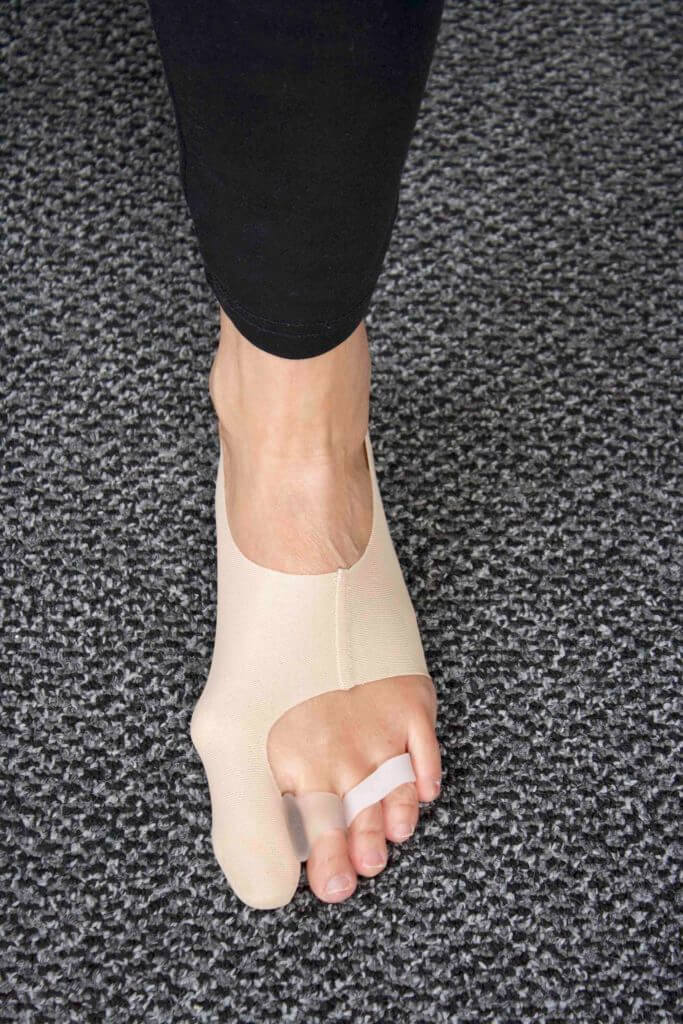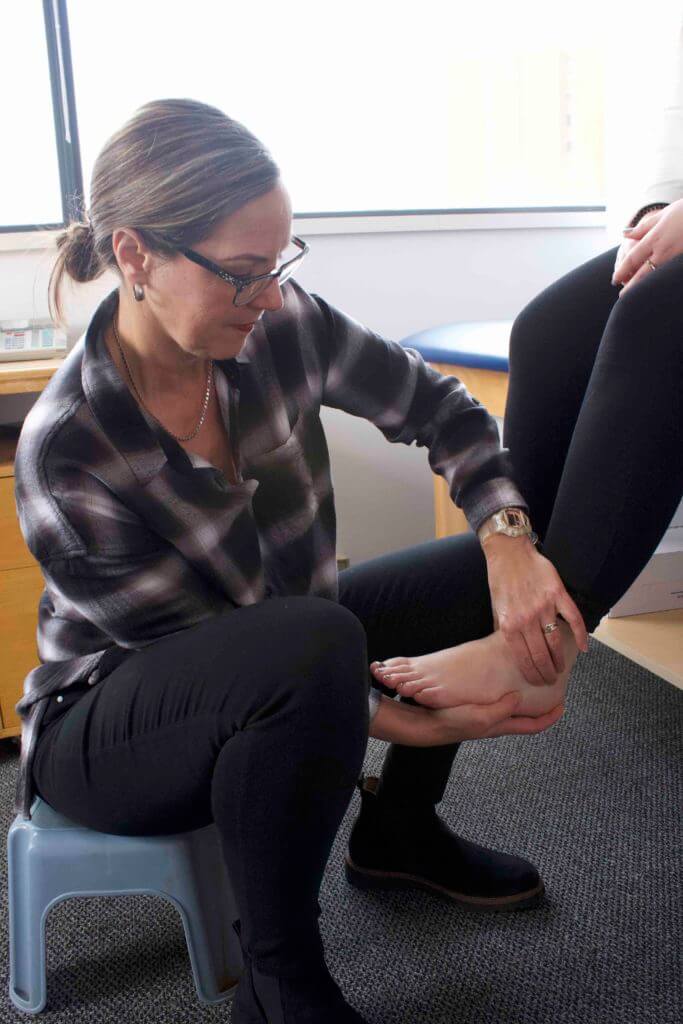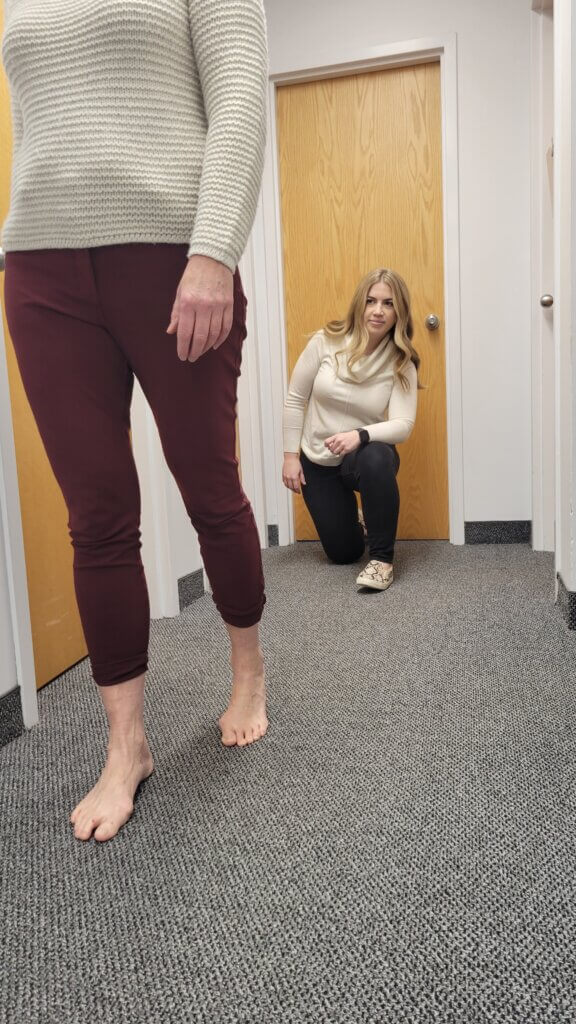Forefoot and Toes
 Metatarsalgia encompasses a number of different conditions and is sometimes considered an umbrella term. Typically this term is used when referring to pain, burning or achiness beneath or on top of the ball of the foot or into the toes. Custom foot orthotics and appropriate footwear may be indicated.
Metatarsalgia encompasses a number of different conditions and is sometimes considered an umbrella term. Typically this term is used when referring to pain, burning or achiness beneath or on top of the ball of the foot or into the toes. Custom foot orthotics and appropriate footwear may be indicated.
Morton’s neuroma is a condition that affects the ball of the foot and the toes. Typically, burning, numbness or sharp/shooting pain is felt down into the toes (most commonly the 3rd and 4th toes). This is caused by thickening or irritation of the nerves that run between the metatarsal into the toes, called interdigital nerves. This injury has a number of causes such as trauma, poor foot structure or improper footwear selection to name a few. Custom foot orthotics and appropriate footwear may be indicated.
Hallux valgus is a deformity of the big toe joint causing shifting of the first toe, or hallux, towards the second toe. Hallux valgus is often related to bunions, which results in a bony build up on the big toe joint or first metatarsal head. This can be caused by altered mechanical load through this joint. While in the past, high heeled shoes were blamed for hallux valgus and bunions, family history and poor movement patterns or biomechanics are more likely to cause this deformity. Custom foot orthotics and appropriate footwear may be indicated. In addition, there are many other foot appliances that can help control the deformity, progression and pain.
Sesmoiditis is an injury or inflammation of the sesamoids which are 2 small bones that are situated in a tendon that runs under the joint of the big toe. Injury to these can occur through direct trauma to the ball of the foot or from inappropriate footwear and certain activities that increase the load through this area. Custom foot orthotics and appropriate footwear may be indicated.
Hammer toes and claw toes are characterized by crooked or bent toes which have a number of different causes from joint instability to muscle imbalances to direct trauma. Typical symptoms of hammer or clawed toes are pain under the ball of the foot into the toe(s) and corns or calluses on the top, between or tip of the affected toe(s). Custom foot orthotics and appropriate footwear may be indicated. There are also many other lesser toe foot appliances that can provide significant relief.
Heel Conditions
Plantar fasciitis or fasciopathy is characterized by pain felt in the heel or arch. Typically it is worse during the first few steps out of bed or after rest, and warms up after a number of steps. Often it is painful after prolonged walking, standing or physical activity. The plantar fascia is a thick, fibrous band that attaches to the heel and fans out into the toes, and is responsible for helping your foot absorb shock as well as aids in propulsion during gait. Custom foot orthotic therapy or appropriate footwear may be indicated.
Achilles tendinitis or tendinopathy is inflammation or irritation within the Achilles tendon, causing pain and swelling at the back of the heel. This injury has many causes, and foot structure and misalignment may play a role in vulnerability to this injury. Custom foot orthotics and appropriate footwear may be indicated.
Severs disease is a type of apophysitis, which is a condition that affects the growth plate of a bone where a tendon attaches in the heel. Severs disease can also be called calcaneal apophysitis. Generally, Severs is found in boys aged 7-15 years old, sometimes during or after a growth period, and particularly in those who are active in sports or exercise that involve a lot of running and jumping, such as soccer, basketball or track and field. Pain associated with Severs is typically located at the back part of the heel, or calcaneus, and is believed to be caused by the tension created at the attachment of the Achille’s tendon. Foot structure and misalignment can be a factor in predisposition to this condition. Custom foot orthotics and appropriate footwear may be indicated.
Leg Conditions
Shin splints, or Medial Tibial Stress Syndrome (MTSS), is typically described as activity induced pain in the lower leg. MTSS is an overuse injury that is commonly found in sports involving lots of running or jumping. Symptoms of MTSS can include; aching in the shin at the start of an activity, but can progress to pain throughout activity as well as during rest afterwards. Swelling along the tibia can also occur. Custom foot orthotics and appropriate footwear may be indicated.
Tibialis posterior tendinitis or tendinopathy: Tibialis posterior is a muscle that is located on the inside of the lower leg that attaches in the foot and is responsible for controlling the amount of collapse of the arch or pronation throughout the gait cycle. Inflammation or pain in this tendon can be caused by overuse, usually in foot structures that have an excessive amount of collapse through the arch of the foot. Custom foot orthotics and appropriate footwear may be indicated.
Knee Conditions
 Patellofemoral pain syndrome (PFPS) causes pain around or behind the kneecap, which increases with squatting, going downstairs, following prolonged activity or while sitting. The patella, or kneecap, slides in a groove in the front of the femur. If the mechanics of the lower leg are abnormal, this alignment can be affected causing subsequent dysfunction and pain. While tissue tightness or muscle imbalances in the pelvis, hip and lower limb often contribute, abnormal foot structure and mechanics and poor footwear can also be a factor. Custom foot orthotics and appropriate footwear may be indicated.
Patellofemoral pain syndrome (PFPS) causes pain around or behind the kneecap, which increases with squatting, going downstairs, following prolonged activity or while sitting. The patella, or kneecap, slides in a groove in the front of the femur. If the mechanics of the lower leg are abnormal, this alignment can be affected causing subsequent dysfunction and pain. While tissue tightness or muscle imbalances in the pelvis, hip and lower limb often contribute, abnormal foot structure and mechanics and poor footwear can also be a factor. Custom foot orthotics and appropriate footwear may be indicated.
The iliotibial band is a tissue that begins in the pelvis and runs along the outside of the leg and attaches just below the knee and helps stabilize the knee. Iliotibial band syndrome (ITBS) occurs from an irritation to this tissue, generally at a small attachment to the femur just before it crosses the knee to attach to the tibia on the outside of the leg. ITBS can be caused by over-training, and is especially common in runners. While tissue tightness or muscle imbalances in the pelvis, hip and lower limb often contribute, abnormal foot structure and mechanics and poor footwear can also be a factor. Custom foot orthotics and appropriate footwear may be indicated.
Osgood-Schlatter’s disease or tibial tubercle apophyseal traction injury is common among younger athletes, and usually is more prevalent in males than females. Typically it involves pain and swelling just below the kneecap, caused by repeated traction on the tendon that attaches the quads and knee cap to the lower leg. As repeated tractional force is applied to this attachment site, bone growth can occur producing a visible lump just below the knee. Sports involving running or jumping, or recent growth spurts can all contribute to developing Osgood-Schlatter disease. Abnormal lower limb, foot structure and mechanics and poor footwear can also be a factor. Custom foot orthotics and appropriate footwear may be indicated.
Hip and Back Conditions
Hip and Back Pain: There are many causes and presentations of hip and back pain and an appropriate diagnoses is imperative. Addressing the structure, function and soft tissue and muscle imbalances is critical to resolution. Lower limb and foot structure, function and mechanics can also affect the hip and back. Since your feet are the interface between the ground and the rest of your body, they are responsible for reducing force by absorbing shock and acting as as stable base of support.. If they are unable to do one or both of these jobs effectively, the instability and damaging force can translate up to the hips and back causing further pain and injury. In addition, muscles higher up may have to work harder to compensate causing additional dysfunction and aggravation. Custom foot orthotics and appropriate footwear may be indicated.
Other Leg Conditions
 Leg length differences can be either ‘functional’ or ‘structural’. Structural leg length differences are true, bony asymmetries where the femur and/or tibia is longer on one side. Functional differences result from structural deviations such as scoliosis, or soft tissue or muscular imbalances that affect the back, pelvis or posture of the lower limb in the hip creating an apparent leg length difference. Conditions such as poliomyelitis, fractures, or hip surgery can result in leg length differences. Whether structural or functional, these asymmetries can result in imbalances and asymmetries resulting in pain and dysfunction. An internal or external lift or Custom foot orthotics and appropriate footwear may be indicated.
Leg length differences can be either ‘functional’ or ‘structural’. Structural leg length differences are true, bony asymmetries where the femur and/or tibia is longer on one side. Functional differences result from structural deviations such as scoliosis, or soft tissue or muscular imbalances that affect the back, pelvis or posture of the lower limb in the hip creating an apparent leg length difference. Conditions such as poliomyelitis, fractures, or hip surgery can result in leg length differences. Whether structural or functional, these asymmetries can result in imbalances and asymmetries resulting in pain and dysfunction. An internal or external lift or Custom foot orthotics and appropriate footwear may be indicated.
Foot issues are one of the most common complications associated with diabetes, due to the changes in skin, sensation or the nerves that supply the feet, and decreased vascular function or an inability to heal as quickly. Depending on the severity of the condition, bony changes can occur in the feet as well, leading to foot deformity. Appropriate foot care as well as Custom foot orthotics and appropriate footwear are imperative for prevention of deformity and complications such as ulcers.
Peripheral neuropathy results from damage to the peripheral nerves in the foot. Neuropathy can affect all the nerves in the foot or only target a single nerve. It presents as tingling, numbness, burning sensations, and a decreased ability to feel pain, pressure and temperature. There can also be a motor component to neuropathy which causes muscle weakness, twitching or cramps and loss of co-ordination. Managing the reason for the neuropathy is an important factor in treatment, whether its diabetes related or due to a specific injury. Custom foot orthotics and appropriate footwear may be indicated.
Osteoarthritis is a ‘wear and tear’ type of arthritis which is caused by breakdown and eventual loss of the cartilage in the joint. Once these changes start to occur, controlling the mechanics of the lower leg and foot is very important as they can change or reduce the load through an arthritic joint leading to reduced pain and progression. Custom foot orthotics and appropriate footwear may be indicated.
Rheumatoid arthritis is an inflammatory disease that causes pain, swelling and stiffness within joints. In this condition, the immune system attacks cells inside the joint capsule which can eventually start to damage the cartilage and bone within the joint. Rheumatoid nodules can form, and lesser toe deformities are common. Custom foot orthotics and appropriate footwear may be indicated.
Ankle sprains are common in activities that involve running, uneven surfaces or sudden turns. Often swelling or bruising can happen after a sprain; however these sprains can become chronic if left untreated. With an ankle sprain, the ligaments of the ankle stretch, or sometimes tear, and reduce the stability within the joint. In addition to the ligaments, tendons, bones and joints themselves are vulnerable to injury creating further instability, pain and dysfunction. Custom foot orthotics and appropriate footwear may be indicated.
